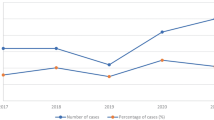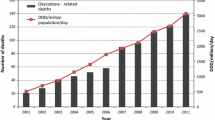Abstract
The American College of Medical Toxicology and the National Association of Medical Examiners convened an expert panel to generate evidence-based recommendations for the practice of death investigation and autopsy, toxicological analysis, interpretation of toxicology findings, and death certification to improve the precision of death certificate data available for public health surveillance. The panel finds the following:
1. A complete autopsy is necessary for optimal interpretation of toxicology results, which must also be considered in the context of the circumstances surrounding death, medical history, and scene findings.
2. A complete scene investigation extends to reconciliation of prescription information and pill counts.
3. Blood, urine, and vitreous humor, when available, should be retained in all cases. Blood from the femoral vein is preferable to blood from other sites.
4. A toxicological panel should be comprehensive and include opioid and benzodiazepine analytes, as well as other potent depressant, stimulant, and anti-depressant medications.
5. Interpretation of postmortem opioid concentrations requires correlation with medical history, scene investigation, and autopsy findings.
6. If death is attributed to any drug or combination of drugs (whether as cause or contributing factor), the certifier should list all the responsible substances by generic name in the autopsy report and on the death certificate.
7. The best classification for manner of death in deaths due to the misuse or abuse of opioids without any apparent intent of self-harm is “accident.” Reserve “undetermined” as the manner for the rare cases in which evidence exists to support more than one possible determination.
Similar content being viewed by others
References
Yaksh TL, Wallace MS (2011) Opioids, Analgesia, and Pain Management. In: Brunton LL, Chabner BA, Knollmann BC (eds) Goodman & Gilman’s The pharmacological basis of therapeutics, 12th edn. The McGraw-Hill Companies, Inc., New York, pp 481–525
CDC 24/7: Saving lives. Protecting people [Internet]. Atlanta: Centers for Disease Control and Prevention; c2011. Morbidity and Mortality Weekly Report (MMWR) November 4, 2011; 60(43); 1487–92. Vital Signs: Overdoses of Prescription Opioid Pain Relievers—United States, 1999–2008; 2011 Nov 4 [cited 2013 Jan 16]. Available from: http://www.cdc.gov/mmwr/preview/mmwrhtml/mm6043a4.htm
Davis GG, National Association of Medical Examiners and American College of Medical Toxicology Expert Panel on Evaluating and Reporting Opioid Deaths (2013) Recommendations for the investigation, diagnosis, and certification of deaths related to opioid drugs. Acad Forensic Pathol 3(1):62–76
Nashelsky MB, Lawrence CH (2003) Accuracy of cause of death determination without forensic autopsy examination. Am J Forensic Med Pathol 24(4):313–319
Forensic Autopsy Performance Standards; 2011 revision [Internet]. Marceline (MO): National Association of Medical Examiners; 2011 Aug 11 [cited 2013 Jan 16]. 27 p. Available from: http://thename.org/index2.php?option=com_docman&task=doc_view&gid=160&Itemid=26
Burt RD, Hagan H, Garfein RS et al (2007) Trends in hepatitis B virus, hepatitis C virus, and human immuno-deficiency virus prevalence, risk behaviors, and preventive measures among Seattle injection drug users aged 18–30 years, 1994–2004. J Urban Health 84(3):436–454
Nolte KB, Taylor DG, Richmond JY (2002) Biosafety considerations for autopsy. Am J Forensic Med Pathol 23(2):107–122
Dinis-Oliveira RJ, Carvalho F, Duarte JA et al (2010) Collection of biological samples in forensic toxicology. Toxicol Mech Methods 20(7):363–414
U.S. National Institute of Justice, Office of Justice Programs [Internet]. Washington: the Institute; [updated 2011 Jun]. Death Investigation: A Guide for the Scene Investigator [updated 2011 Jun; cited 2013 Jan 16]. Available from: http://www.nij.gov/pubs-sum/234457.htm
Gruszecki AC, Booth J, Davis GG (2007) The predictive value of history and scene investigation for toxicology results in a medical examiner population. Am J Forensic Med Pathol 28(2):103–106
Ceelen M, Dorn T, Buster M et al (2011) Post-mortem toxicological urine screening in cause of death determination. Hum Exp Toxicol 30(9):1165–1173
Cina SJ, Collins KA, Goldberger BA (2011) Toxicology: What is routine for medicolegal death investigation purposes? Acad Forensic Pathol 1(1):28–31
Poulin C, Stein J, Butt J (1998) Surveillance of drug overdose deaths using medical examiner data. Chronic Dis Can 19(4):177–182
Dinis-Oliveira RJ, Santos A, Magalhães T (2012) “Foam Cone” exuding from the mouth and nostrils following heroin overdose. Toxicol Mech Methods 22(2):159–160
Gill JR, Graham SM (2002) Ten years of “body packers” in New York City: 50 deaths. J Forensic Sci 47(4):843–846
Linnet K, Johansen SS, Buchard A et al (2008) Dominance of pre-analytical over analytical variation for the measurement of methadone and its main metabolite in postmortem femoral blood. Forensic Sci Int 179(1):78–82
Skopp G (2004) Preanalytic aspects in postmortem toxicology. Forensic Sci Int 142(2–3):75–100
Hargrove VM, McCutcheon JR (2008) Comparison of drug concentrations taken from clamped and unclamped femoral vessels. J Anal Toxicol 32(8):621–625
Thompson JG, Vanderwerf S, Seningen J et al (2008) Free oxycodone concentrations in 67 postmortem cases from the Hennepin County Medical Examiner’s Office. J Anal Toxicol 32(8):673–679
Andresen H, Gullans A, Veselinovic M et al (2012) Fentanyl: toxic or therapeutic? Postmortem and antemortem blood concentrations after transdermal fentanyl application. J Anal Toxicol 36(3):182–194
Cook DS, Braithwaite RA, Hale RA (2000) Estimating antemortem drug concentrations from postmortem blood samples: the influence of postmortem redistribution. J Clin Pathol 53(4):282–285
Ferner RE (2008) Post-mortem clinical pharmacology. Br J Clin Pharmacol 66(4):430–443
Pleuvry BJ (2005) Pharmacodynamic and pharmacokinetic drug interactions. Anaesth Intensive Care Med 6(4):129–133
Ceder G, Jones AW (2001) Concentration ratios of morphine to codeine in blood of impaired drivers as evidence of heroin use and not medication with codeine. Clin Chem 47(11):1980–1984
Jones AW, Holmgren A (2011) Concentration ratios of free-morphine to free-codeine in femoral blood in heroin-related poisoning deaths. Leg Med (Tokyo) 13(4):171–173
Madras BK, Kaufman MJ (1994) Cocaine accumulation in dopamine-rich regions of the brain after i.v. administration: comparison with mazindol distribution. Synapse 18(3):261–275
Cone EJ, Fant RV, Rohay JM et al (2004) Oxycodone involvement in drug abuse deaths. II: Evidence for toxic multiple drug-drug interactions. J Anal Toxicol 28(7):616–624
National Center for Health Statistics. Medical examiners’ and coroners’ handbook on death registration and fetal death reporting. Hyattsville, MD: Department of Health and Human Services, Centers for Disease Control and Prevention, National Center for Health Statistics; 2003 [cited 2013 Jan 26]. Available from: http://www.cdc.gov/nchs/data/misc/hb_me.pdf
Rosenberg ML, Davidson LE, Smith JC et al (1988) Operational criteria for the determination of suicide. J Forensic Sci 33(6):1445–1456
Acknowledgments
The panelists gratefully acknowledge the technical support and expertise that librarians Gale Hannigan and Brian Bunnett of the University of New Mexico Health Sciences Library provided by searching the literature, gathering articles, checking citations and recording the outcome of the review process. In addition, the panelists are thankful for the assistance of Denise McNally of the National Association of Medical Examiners for facilitating the multiple conference calls required to produce the final document.
Disclosures
Funding support for this project was received from the Centers for Disease Control and Prevention (CDC), contract number 00HCUD32011-99784. The findings and conclusions in this report are those of the authors and do not necessarily represent the official position of the CDC. Drs Aiken, Greg G. Davis, Gill, Goldberger, Melinek, Middleberg, Middleton, Nelson, Perrone and Wax received travel funds from the CDC award to participate in the expert panels. Drs Goldberger and Middleberg received honoraria for their participation in the expert panel. Drs Boyer, Gill, Melinek, Nelson and Goldberger have received fees to be expert consultants and provide testimony in legal matters. Drs Gharibo and Gill have received payments for lectures. Dr. Gill has received royalties from the publication of scientific books and the development of a Medicolegal course. Dr. Middleberg is employed by the NMS laboratory which has done fee-for-service work for the CDC. Dr. Nolte’s institution, the New Mexico Office of the Medical Investigator, received funds from the CDC to support the creation of this paper including his role as principal investigator and receives funds from the National Association of Medical Examiners (NAME) to support his role as Executive Vice President. In addition, Dr. Nolte’s institution has research awards in which he participates from the National Institute of Justice and National Institutes of Health (through Portland State University). Dr. Wax receives funds from the American College of Medical Toxicologists to be the Executive Director.
The opinions and conclusions of this paper have been reviewed and approved by the National Association of Medical Examiners Board of Directors and as such are endorsed by NAME. These opinions and positions are based on a consensus of the current literature, knowledge, and prevailing theories on this topic. As Scientific knowledge and experience grow, NAME reserves the right to revise or update these opinions. The process by which NAME position papers are initiated, written, reviewed, and approved is publically available at https://netforum.avectra.com/temp/ClientImages/NAME/2c26a527-f992-4f70-9d03-7941bff5319d.pdf. All scientific position papers endorsed by the National Association of Medical Examiners automatically expire 5 years after publication unless reaffirmed, revised, or retired at or before that time. This work is a product of NAME and as such, was not subjected to Academic Forensic Pathology Journal editorial review.
The editors and publication staff do not report any relevant conflicts of interest.
Author information
Authors and Affiliations
Consortia
Additional information
This article is a complete republication of a primary publication by Academic Forensic Pathology from Acad Forensic Pathol 2013 3 (1): 77-83 with permission
Rights and permissions
About this article
Cite this article
Gregory G. Davis MD MSPH and the National Association of Medical Examiners and American College of Medical Toxicology Expert Panel on Evaluating and Reporting Opioid Deaths. Complete Republication: National Association of Medical Examiners Position Paper: Recommendations for the Investigation, Diagnosis, and Certification of Deaths Related to Opioid Drugs. J. Med. Toxicol. 10, 100–106 (2014). https://doi.org/10.1007/s13181-013-0323-x
Published:
Issue Date:
DOI: https://doi.org/10.1007/s13181-013-0323-x




